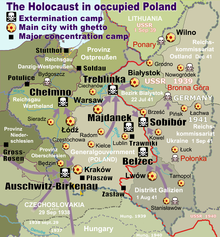51°13′14″N 22°35′58″E / 51.22056°N 22.59944°E
| Majdanek / Lublin | |
|---|---|
| Nazi concentration camp | |
 | |
| Location | Near Lublin, General Government (German-occupied Poland) |
| Operated by | SS-Totenkopfverbände |
| Commandant |
|
| Original use | Forced labor |
| Operational | October 1, 1941 – July 22, 1944 |
| Inmates | Jews, Poles |
| Number of inmates | 150,000 |
| Killed | Estimated 78,000 |
| Liberated by | Soviet Union, July 22, 1944 |
Majdanek (or Lublin) was a Nazi concentration and extermination camp built and operated by the SS on the outskirts of the city of Lublin during the German occupation of Poland in World War II. It had seven gas chambers, two wooden gallows, and some 227 structures in all, placing it among the largest of Nazi concentration camps.[1] Although initially intended for forced labor rather than extermination, it was used to murder people on an industrial scale during Operation Reinhard, the German plan to murder all Polish Jews within their own occupied homeland.[2] In operation from 1 October 1941 to 22 July 1944, it was captured nearly intact. The rapid advance of the Soviet Red Army during Operation Bagration prevented the SS from destroying most of its infrastructure, and Deputy Camp Commandant Anton Thernes failed to remove the most incriminating evidence of war crimes.[3]
The camp was nicknamed Majdanek ("little Majdan") in 1941 by local residents, as it was adjacent to the Lublin ghetto of Majdan Tatarski. Nazi documents initially described the site as a POW camp of the Waffen-SS, based on how it was funded and operated. It was renamed by the Reich Security Main Office as Konzentrationslager Lublin on April 9, 1943, but the local Polish name remained more popular.[4]
After the camp's liberation in July 1944, the site was formally protected by the Soviet Union.[5] By autumn, with the war still raging, it had been preserved as a museum. The crematorium ovens and gas chambers were largely intact, serving as some of the best examples of the genocidal policy of Nazi Germany. The site was given national designation in 1965.[6] Today, the Majdanek State Museum is a Holocaust memorial museum and education centre devoted entirely to the memory of atrocities committed in the network of concentration, slave-labor, and extermination camps and sub-camps of KL Lublin. It houses a permanent collection of rare artifacts, archival photographs, and testimony.[7]
- ^ "Majdanek".
- ^ Cite error: The named reference
Reszkawas invoked but never defined (see the help page). - ^ Nicholas, Lynn H. (2009). Cruel World: The Children of Europe in the Nazi Web. Knopf Doubleday Publishing Group. ISBN 978-0-307-73971-1.
- ^ "Założenia i budowa (Purpose and construction, selection of photographs)". Majdanek concentration camp. KL Lublin Majdanek.com.pl. Archived from the original on January 2, 2011. Retrieved 2013-04-18.
Concentration camp name change 9.04.1943.
- ^ "Majdanek" (PDF). Majdanek concentration camp. Yad Vashem. 2007. Archived from the original (PDF) on November 27, 2007. Retrieved 2013-04-14.
- ^ Cite error: The named reference
majdanek.eu-Kalendariumwas invoked but never defined (see the help page). - ^ "Regulamin organizacyjny Państwowego Muzeum na Majdanku". Dz. U. z 1947 r. nr 52, poz. 265. Biuletyn Informacji Publicznej (Bulletin of Public Information, Republic of Poland). 2006. Archived from the original on March 3, 2016. Retrieved April 28, 2013.
